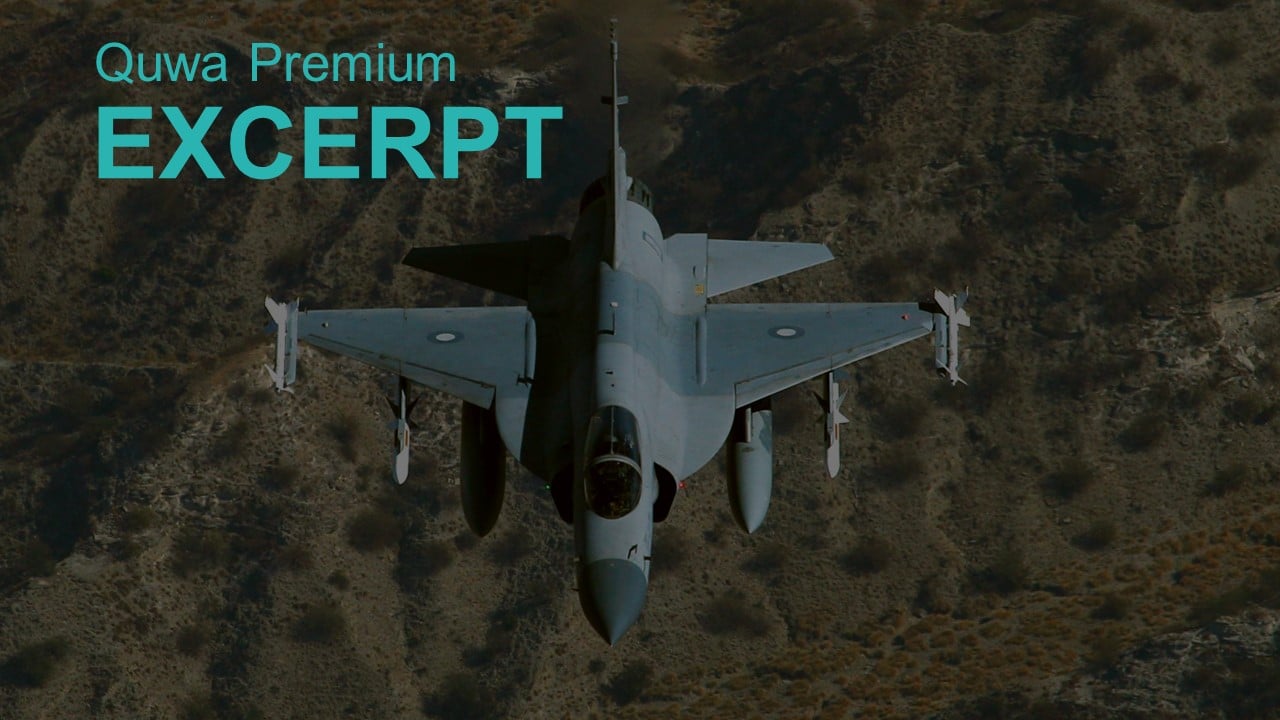2088Views

Pakistan’s Quest for a Domestic Fighter (Part 2): The JF-17 Emerges as Pakistan’s Mainstay Fighter
This is a continuation of Quwa’s series, “Pakistan’s Quest for a Domestic Fighter.” In Part 1, we examined the events that lead to the eventual development of the JF-17, particularly in the late 1980s when Pakistan had studied using an extensively modified F-7M as a complement to the F-16.
In 2010, the Pakistan Air Force (PAF) inducted its first squadron equipped with the JF-17 Thunder, its new, mainstay multi-role fighter that is developed in collaboration with the Aviation Industry Corporation of China (AVIC). Since its entry, the JF-17 is now in use with six PAF squadrons located across Pakistan. Be it the country’s maritime operations environment, the plains and deserts of interior Punjab and Sindh or the mountains of Baluchistan, Northern Areas and the Himalayas, the JF-17 is the PAF’s workhorse.
Thus far, it appears Pakistan Aeronautical Complex (PAC) has (with AVIC’s support) rolled-out more than 100 JF-17 Block-I and Block-IIs; the next phase of the program is the highly anticipated JF-17 Block-III. At this stage, it is evident that the JF-17 has fulfilled the PAF’s longstanding need for an affordable, versatile and, not least, sanction-free backbone fighter. The Block-III included, the intent is to build a fleet of more than 150 (i.e. 162) fighters, potentially up to 200 (or more).[1][2]
Granted, the PAF’s efforts to procure larger multi-role fighters – specifically, additional Lockheed Martin F-16C/D Block-52+ or (in lieu of F-16s) a Russian or Chinese fighter – overshadowed the inherently strong attributes of the JF-17. It is not just a matter of supplanting the PAF’s legacy Chengdu F-7P, but delivering – and that too in sizable numbers – contemporary air warfare capabilities across the entire PAF fleet. From beyond-visual-range air-to-air missiles (BVRAAM) to stand-off weapons (SOW), the JF-17 has delivered.
Consider the impact of more than doubling the PAF’s ability to deliver active radar-guided beyond-visual-range air-to-air missiles (BVRAAM) from 74 F-16 Block-52+/MLU to 174+ F-16s and JF-17s; or doubling the number of squadrons capable of anti-ship warfare (AShW) stationed at Masroor Air Base; or enlarging the number of precision-strike-capable, ground-attack fighters through the ASELPOD; and adding to the PAF’s fleet of network-enabled combat platforms through tactical data-links (TDL) are credible gains.
However, when coupled with the fact that the PAF has flexibility to configure the JF-17 at-will (albeit within its financial and technical confines), the JF-17 offers advancement. Strict end-user controls on the F-16 – and most other imported fighters – leaves the JF-17 as the PAF’s sole means of readily using new weapon technologies. Be it active electronically-scanned array (AESA) radars, SOWs, electronic warfare (EW) and electronic countermeasures (ECM) suites, new Air Staff Requirements (ASR) have less of a barrier.
Combine the PAF’s freedom to configure its platform alongside its ability to fully support the JF-17’s long-term maintenance, manufacture aerostructures for overhaul and repair, and supplant old airframes with new ones, the JF-17 is a vital asset. However, this control has also opened the PAF’s door to explore new or specialist roles it would not consider if strictly tied to imports. Be it through newbuild airframes or by re-allocating – but retrofitting – older Block-Is, the PAF can explore a number of options.
End of Excerpt (517/1,525 words)
The full article is available to Quwa Premium subscribers here.
[1] Alan Warnes. “Dubai Airshow: Pakistan JF-17 returns to Dubai.” Arabian Aerospace. 13 November 2017. URL: https://www.arabianaerospace.aero/dubai-airshow-pakistan-jf-17-returns-to-dubai.html (Last Accessed: 16 September 2018).
[2] Alan Warnes. “JF-17 Thunder: Pakistan’s multi-role fighter.” Note: a special publication released by the Pakistan Air Force during the Paris Air Show of 2015.


